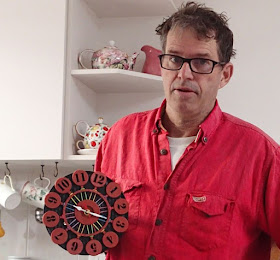 |
| My asymmetric surfboard ..... |
 |
| started life as a carbon-fibre reinforced Trigger Brothers windsurfer. |
 |
| At Spout Creek |
 |
| Quite an old photo! |
 |
| The half-template |
 |
| The Asym bit. Rectangle marks the finbox position. |
Hi
For more years than I care to remember, I have been a surfer, and have spent many holidays and weekends by the beach bobbing about in the water. My family is very lucky to have access to a house at the coast, and for a long time Howard Hughes ran the local surf shof and I got boards through him.
Alan Atkins used to surf one of the local breaks and I admired his style, and he surfed these big long surfboards, up around the 8' mark and it helped his big wave surfing look effortless, so I bought a similar thruster surfboard from Howard. Some time later I broke that board at Johanna, and I had broken a series of boards before that, and I was really sick of it so decided to use old windsurfers for my surfboards. I bought one or two cheaply off Howard (from free for a creased one to $100 for some others, and I was sort of used to their size and floatation, having surfed 8' mals.
So old windsurfers have been my boards for the last 25 years or so (my son was in creche when I broke the board at Johanna, now he is married and buying a house ) and I still look out for them on ebay, and they are still quite cheap craftspieces from surfboardmakers of the 1980s.
My last board was a Trigger Brother's windsurfer with carbon fibre reinforcement and it worked well but was getting long in the tooth and leaking and going brown, so started looking for a replacement, and after reading articles like
this one on Swellnet, thought that I could get a Swallow tail board, and get it modded to be an Asym to suit me, a goofy cum switchfoot. And that's just what I did, taking the board to Zak Surfboards in nearby landlocked Thornbury for the mod which cost me about $150, the same as the board cost me in the first place.
After a little bit of practice I got used to it and really like it now. But would now like to take the thing further. My particular Asym only suits a goofy, but I am keen to take the idea further, making a double ended Asym with one end that suits a goofy and the other end that suits a natural footer.
So until a few days ago I'd done nothing about it but I was down the coast a few days ago, and had walked to the cliff with surfboard and wettie. It was too cold to be outside, let alone contemplate going out in the surf which was ok but a bit small, so after checking out the surf, then turning back without going in, walked along the cliff for a bit, lingering on the clifftop for a bit longer to get a few more ocean glimpses. And when I'd stopped to check out the surf again, I started chatting to a lady who turned out to be legendary surfer Gail Cooper, and we were talking all about windsurfers and asymmetric surfboards and even that I also design bicycles.
So I got inspired, and started on the making path for the surfboard. At the next opportunity, I traced the planshape for the Trigger Brothers asym and will get working on a double ender asym. Zak's recommended
Akushape software, and I will probably use that but first I plan to make a model of the board and fin using Solidworks and my 3d printer. I will report on how it goes here at the design blog.
Regards
Steve Nurse.

























































